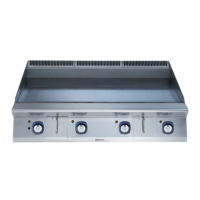24
G.2 External parts
SATIN-FINISH STEEL SURFACES (daily)
• Clean all steel surfaces: dirt is easily removed when it has
just formed.
• Remove grime, fat and other cooking residuals from steel
surfaces when cool using soapy water, with or without
detergent, and a cloth or sponge.
Dry the surfaces thoroughly after cleaning.
• In case of encrusted grime, fat or food residuals, go over
with a cloth or sponge, wipe in the direction of the satin
finish and rinse often:
Rubbing in a circular motion combined with the particles of
dirt on the cloth/sponge could spoil the steel’s satin finish.
• Metal objects can spoil or damage the steel: damaged
surfaces become dirty more easily and are more subject to
corrosion.
• Restore the satin finish if necessary.
SURFACES BLACKENED BY HEAT (when necessary)
• Exposure to high temperatures can cause the formation of
dark marks.
These do not constitute damage and can be removed by
following the instructions given in the previous section.
G.3 Internal parts (every year)
IMPORTANT
Operations to be carried out only by specialised
personnel.
• Check the condition of the internal parts.
• Remove any deposits of dirt inside the appliance.
• Check and clean the discharge system.
IMPORTANT
In particular conditions (e. g. intensive use of the
appliance, salty environment, etc.) the above
cleaning should be more frequent.
G.4 Tank cleaning (daily)
WARNING
It is advisable to carry out this
operation after the appliance has
cooled (the inertia of heating,
even if switched off, can damage
the tank if empty).
If this is not possible, fill the tank
with cold water at the same time
as emptying the cooking water.
WARNING
Do not use steel wool, metal
object and / or products contain-
ing chloride which could damage
the stainless steel surface.
• Drain completely the water from the tank (see paragraph F.7
Water drain)..
• Remove any residuals of food, grime, fat, other cooking
residuals and starch from the tank and baskets, using soapy
water, with or without detergent, applied with a cloth or
sponge, when cool.
• Rinse carefully tank and baskets removing any residual of
detergent.
• Carefully dry the tank and baskets to avoid the
stagnation of liquids.
G.5 Scale
Steel surfaces (when necessary)
• Remove any scale (stains or marks) left by water on steel
surfaces using suitable natural detergents (e.g. vinegar) or
chemical (e.g. "STRIPAWAY" produced by ECOLAB).
Vinegar
• Heat for about 5 minutes.
• Allow the vinegar to work for at least 20 minutes.
• Rinse with plenty of demineralised water.
Chemical detergent
• Heat for about 3 minutes.
• Allow the solution to work for at least 10 minutes.
G.6 Idle periods
If the appliance is not going to be used for some time, take the
following precautions:
• Close the valves or main switches ahead of the appliances;
• Go over all stainless steel surfaces vigorously with a cloth
moistened with paraffin oil in order to create a protective
film;
• Periodically air the premises;
• Have the appliance checked before using it again;
• For the electric heated models: switch the machine On at
the minimum rate of heat for at least 45 minutes; this will
allow moisture/humidity accumulated into the heating
elements to evaporate without damaging the elements.
G.7 Brief Troubleshooting guide
All components requiring maintenance are accessible from the front of the appliance, after removing the control panel and front
panel.
Even with normal use, malfunctions can occur.
Malfunction Possible causes:
The pilot burner does not light.
• Insufficient pressure in gas pipes
• Nozzle blocked.
• Faulty gas valve.
The pilot burner goes out.
• The pilot burner is not heating the thermocouple sufficiently.
• The gas valve knob is not being pressed enough.
• Lack of gas pressure at the valve.
• Faulty gas valve.

